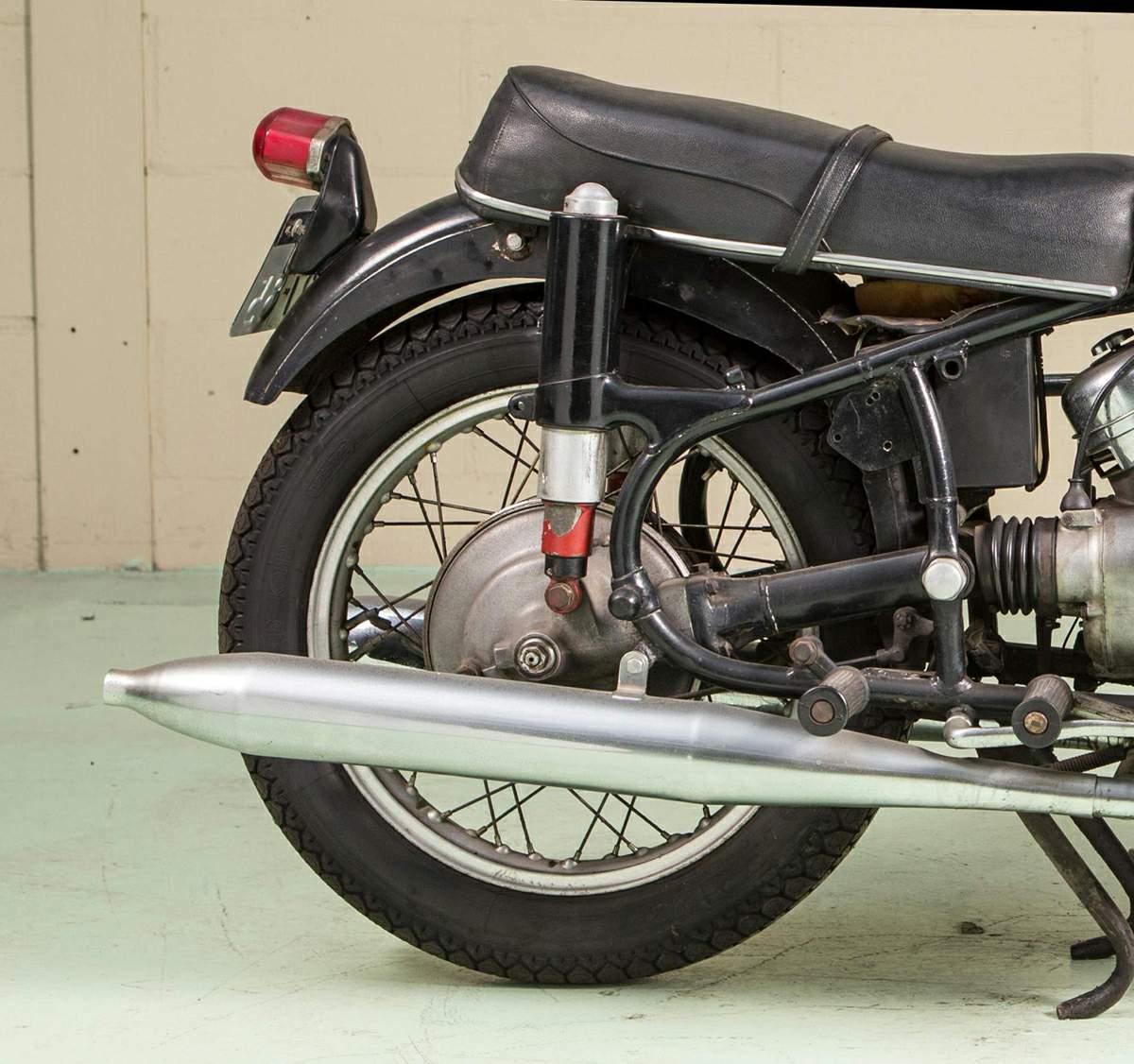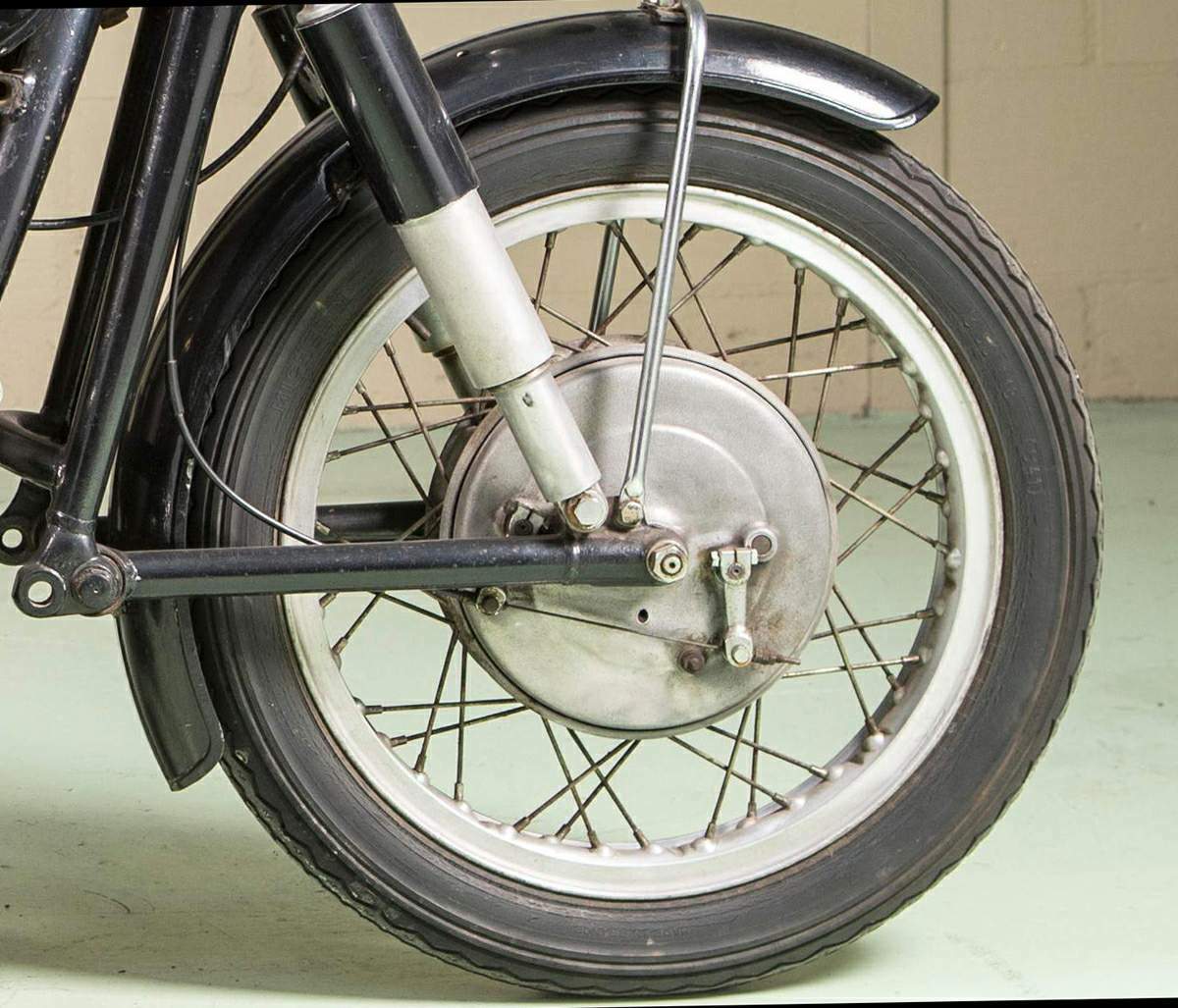|
Make Model |
BMW R 50 |
|
Year |
1955 - 60 |
|
Engine |
Four stroke,
two cylinder horizontally opposed Boxer, pushrod operated 2 valves per cylinder. |
|
Capacity |
494 cc / 30.1 cu in. |
|
Bore x Stroke |
68 x 68 mm |
|
Compression Ratio |
6.8:1 |
|
Cooling System |
Air cooled |
|
Induction |
2 x Bing
1/24/45 - 1/24/46 carburetors |
|
Ignition |
Magneto ignition |
|
Starting |
Kick |
|
Clutch |
Single plate saucer spring, dry |
|
Max Power |
19.4 kW / 26 hp @ 5800 rpm |
|
Transmission |
4 Speed |
|
Final
Drive |
Shaft |
|
Gear Ratio |
1st 5.33 / 2nd 3.02 / 3rd 2.04 / 4th 1.54:1 |
|
Frame |
Double loop steel tubular frame |
|
Front Suspension |
Telescopic fork |
|
Rear Suspension |
Long swing arm with
suspension units and oil pressure shock absorbers |
|
Front Brakes |
∅200mm Drum, duplex full hub |
|
Rear Brakes |
∅200mm Drum, simplex full hub |
|
Front Tyre |
3.50 -18" |
|
Rear Tyre |
3.50 -18" |
|
Wet-Weight |
195 kg / 429 lbs |
|
Fuel Capacity |
17 liters
/ 4.49 US gal |
BMW's first post war production
twin cylinder motorcycle was the 496cc R51/2 introduced during 1950. This
variant was replaced during 1954 by the R50 which introduced a pivoted fork
rear frame combined with Earles forks at the front. Endowed with great
stamina and a smooth ride the model, although expensive, found favour with
discerning long distance riders and police forces throughout Europe.
Replacing the R51/3 and R68tn
1955 were two new twins, the R50 and R69. These featured front and rear
swtngarm suspension patterned on the RS54 racer. The driveshaft was now
enclosed in the right-side of the swingarm. with the universal joint moved
to the gearbox end. The next year saw a touring R60. but this coincided with
a serious slump in motorcycle sates. During 1957. several German
manufacturers (including Adier. dkW and Horex) disappeared, while BMW's
motorcycle production slumped to less than 5500. There was virtually no
motorcycle development for five years, and BMW faced bankruptcy in 1959. A
rally of shareholders saw the company survive and. during i960, the
motorcycle range was developed and improved
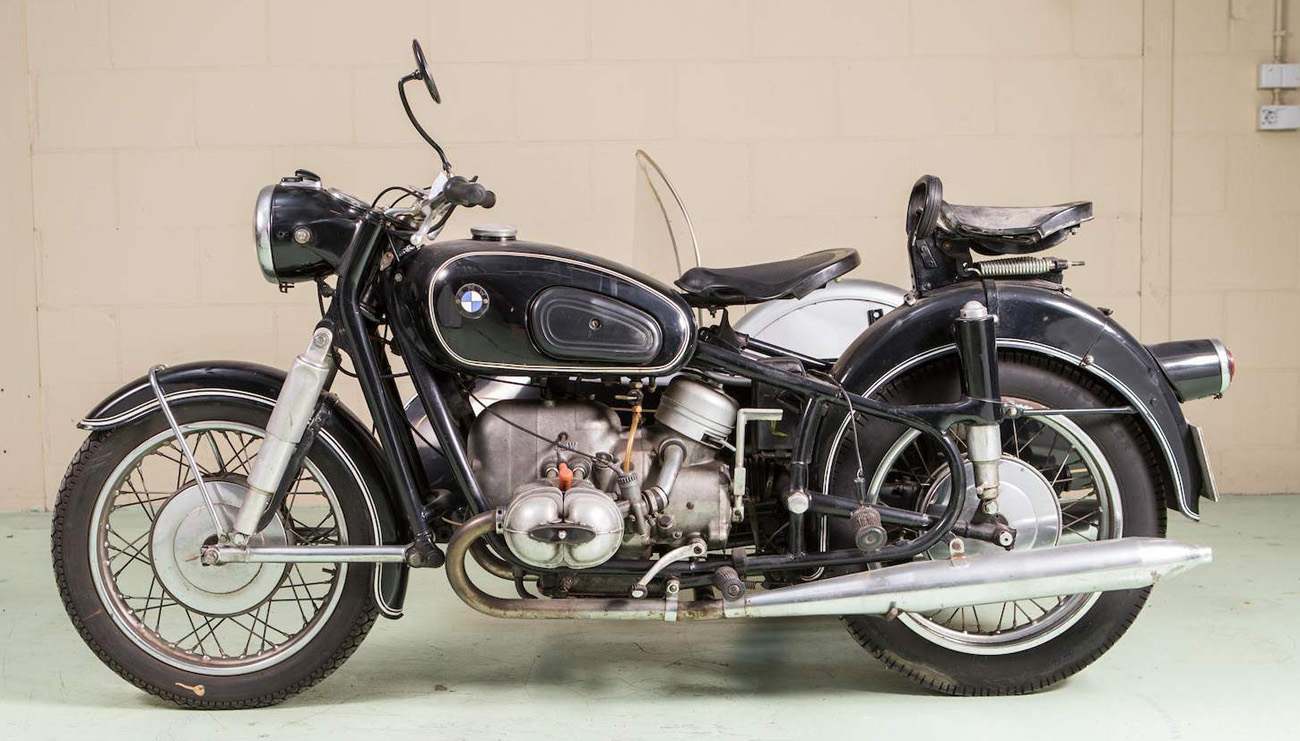
"Motor Cycle Magazine", July
7, 1955 Road test of new models
Summary: Vibrationless flat twin
with shaft drive
Exceptional comfort, quietness and cleanliness
Outstanding braking, steering and road-holding
For more than thirty years, BMWs have pinned their faith to the flat-twin
engine with its almost perfect balance and its excellent cooling when
transversely mounted. During that period, the famous German marquee has also
earned renown for allegiance to shaft transmission, cleanliness of power
units and high quality of workmanship. On a number of occasions, BMWs have
been among the pioneers of new trends in design. Specific instances include
the adoption of welded frame construction and hydraulically damped,
telescopic front forks. The latest R50, a high-performance touring
five-hundred, introduced at the 1955 Brussels Show, abundantly maintains the
makers' reputation for up-to-date design, first-class engineering and
outstanding all-round performance.
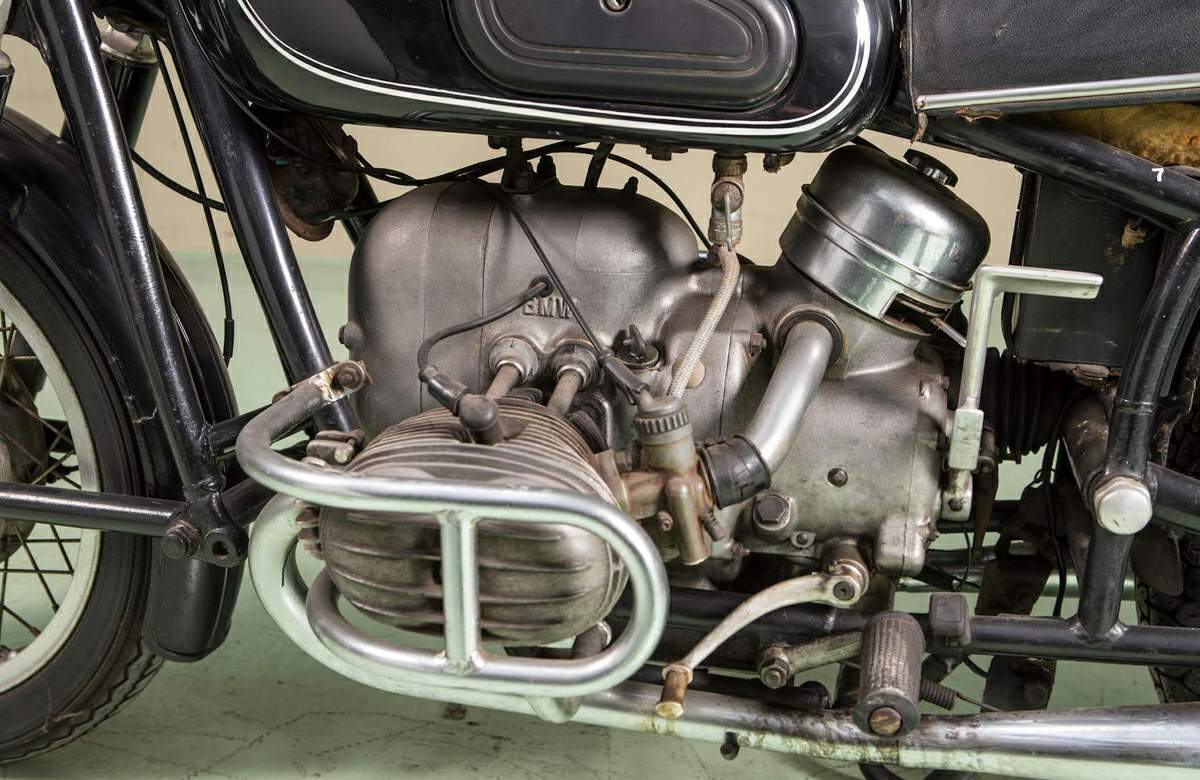
The new model features pivoted-fork springing at front and rear, and the
transmission shaft is enclosed in the right-hand member of the rear fork.
Road behavior of the R50 is extremely gentlemanly. Indeed, it is difficult
to visualize a machine of conventional conception being more smooth, quiet,
comfortable and clean to ride. Except during inclement weather, the machine
could be ridden in ordinary walking clothes without any fear of their
becoming soiled.
At all speeds from normal tickover to valve float, the engine was
turbine-smooth in operation. Only when the unit was idling extremely slowly
was there a trace of lateral judder. Flywheel inertia is high and
contributes to the exceptional sweetness of the transmission. On its low
bottom-gear ratio of 16.95 to 1, the R50 would trickle along at moderate
walking speed with the clutch fully engaged and would accelerate smoothly
from that speed merely as the result of the twistgrip being opened.
An ingenious twistgrip design gives a graduated rate of opening of the two
throttles. A bevel gear on the twistgrip sleeve actuates a similar gear
which operates both throttle wires through a cam device. As a result,
twistgrip action is slow in the lower ranges of throttle opening and becomes
progressively more rapid as the degree of opening is increased. The delicacy
of throttle control thus afforded enhanced the smooth operation of engine
and transmission and removed much of the irritation from negotiation of
heavy traffic.
Engine starting was effortless and certain. Preliminary requirements were
merely to close the strangler, momentarily depress each float tickler and
switch on the ignition. With the twistgrip set for a fast tickover, the
engine invariable came to life at the first depression of the kick-starter
The starter pedal moves in a transverse plane and it was a simple matter for
the rider to operate it with his right foot while standing on the left of
the machine.
When the strangler is closed, the carburettors are fed with filtered air
from inside the crankcase casting. During the moderately warm weather which
prevailed for the test period, the strangler was opened as soon as the
engine fired. Idling was slow an reliable whether the engine was hot or
cold.
One of the most outstanding characteristics of the power unit was its
quietness of operation. The level of mechanical noise was probably as low as
that of any air-cooled, poppet-valve engine. There was never more than the
subdued rustle of well-oiled machinery. The pleasant hum from the
interconnected exhausts reflected the fact that exhaust noise is controlled
by legislation in Germany. Indicative of the unusually high standard of
mechanical and exhaust quietness achieved by the BMW engineers is that the
noise which was most perceptible to the rider at a level-road speed of 40
mph in top gear was that made by the front tire on the road.
Acceleration was zestful without being tigerish, but was chiefly notable for
its sweetness whether the engine speed was high or low. When ridden in
built-up areas, the R50 provided silky, unobtrusive travel at 30 mph in top
gear. On the open road, there was no mechanical consideration such as engine
vibration, noise or lack of riding comfort to influence the rider's choice
of cruising speed. With the rider normally seated, any indicated speed from
11 to 90 mph was equally pleasant and comfortable, except that there was
almost-imperceptible "hardness" in power delivery at about 57 mph in top
gear.
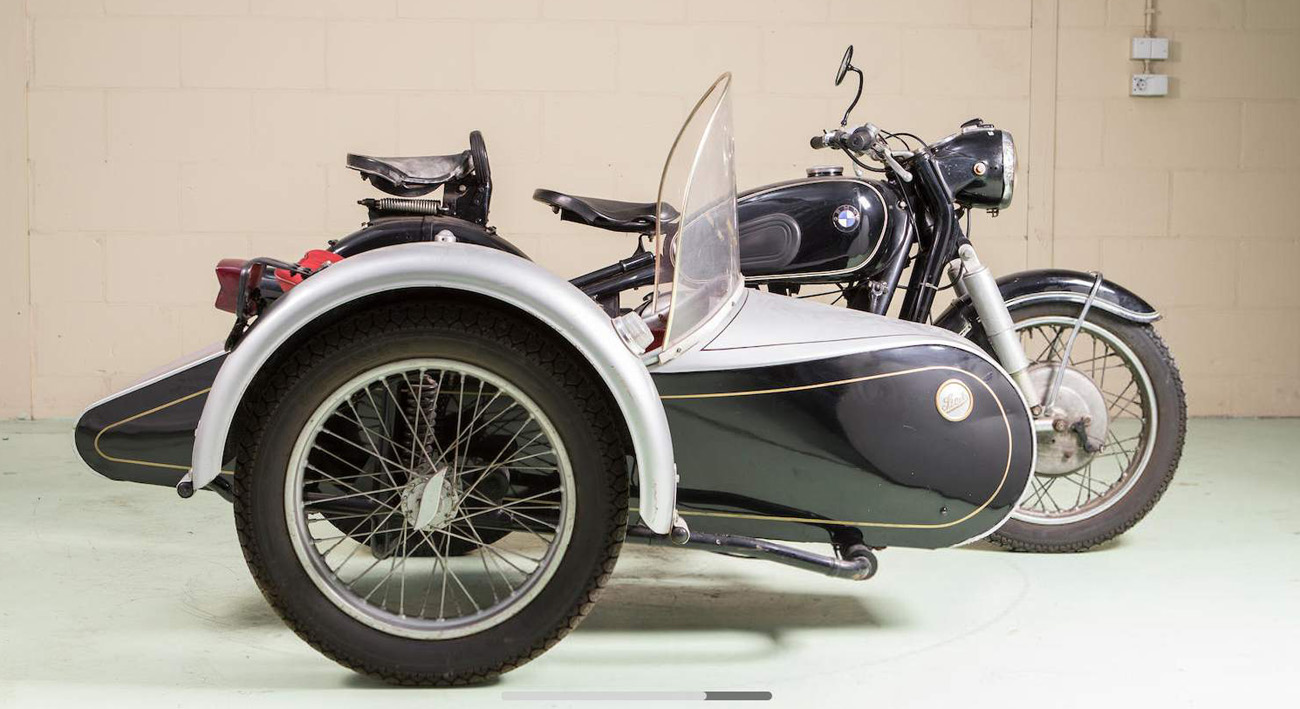
The transverse disposition of the engine results in most efficient air
cooling of the cylinders and cylinder heads, and sustained cruising at about
80 mph, failed to evoke the slightest sign of distress from the power unit.
When checked for accuracy, the speedometer proved to read fast by
approximately 10 per cent at all speeds.
Wide spacing of the gear ratios and a relatively heavy engine speed clutch
combined to make clean gear changes difficult. For upward changes the
technique which was most effective in minimizing clashing of the dogs was to
apply firm upward pressure to the gear pedal before the clutch and throttle
controls were operated, so that the gears were shifted as soon as the clutch
was slipped and the twistgrip eased. Because of high flywheel inertia it was
necessary to re-engage the clutch gently if a slight lurch of the machine
was to be avoided. Downward changes were best effected with a firm, quick
pedal movement and an appreciable increase in engine speed.
Engagement of bottom gear with the engine idling slowly was usually quiet
and neutral was easily located from bottom or second gears. A green light in
the headlamp shell indicates that neutral is selected. Take-up of the drive
was confined to a relatively small range of movement of the clutch lever but
it was by no means difficult to ensure a smooth getaway.
Slightly heavy at ultra-low speeds, the steering was otherwise superb.
Though the steering damper was never brought into play, straight-ahead
steering was rock steady. For test purposes the rider's hands were removed
from the handlebar at maximum speed with complete confidence. Bend swinging
and cornering were equally delightful. The machine could be heeled over
stylishly on slow or fast curves in the sure knowledge that it would follow
the chosen line faithfully. No components fouled the road however steeply
the R50 was banked. The center-stand extension -- on many machines an
offender in this connection -- is neatly recessed into the underside of the
left-hand silencer. For all practical purposes, the effects of torque
reaction (during acceleration and deceleration) arising from the transverse
mounting of the engine were unnoticeable.
With a comparatively rearward footrest setting, the riding position is such
as to render long periods of high-speed riding untiring to the rider. The
slight forward crouch involved did not prove to be uncomfortable for
low-speed work in town. To match the offset of the cylinders, the BMWs
footrests are staggered slightly, but the effect ceased to be noticeable
after the first few moments spent in the saddle. Though the gear pedal is
not adjustable for position and the handlebar grips, complete with their
built-in control clusters, can be rotated only on the bar, the sitting of
every control was just about perfect.
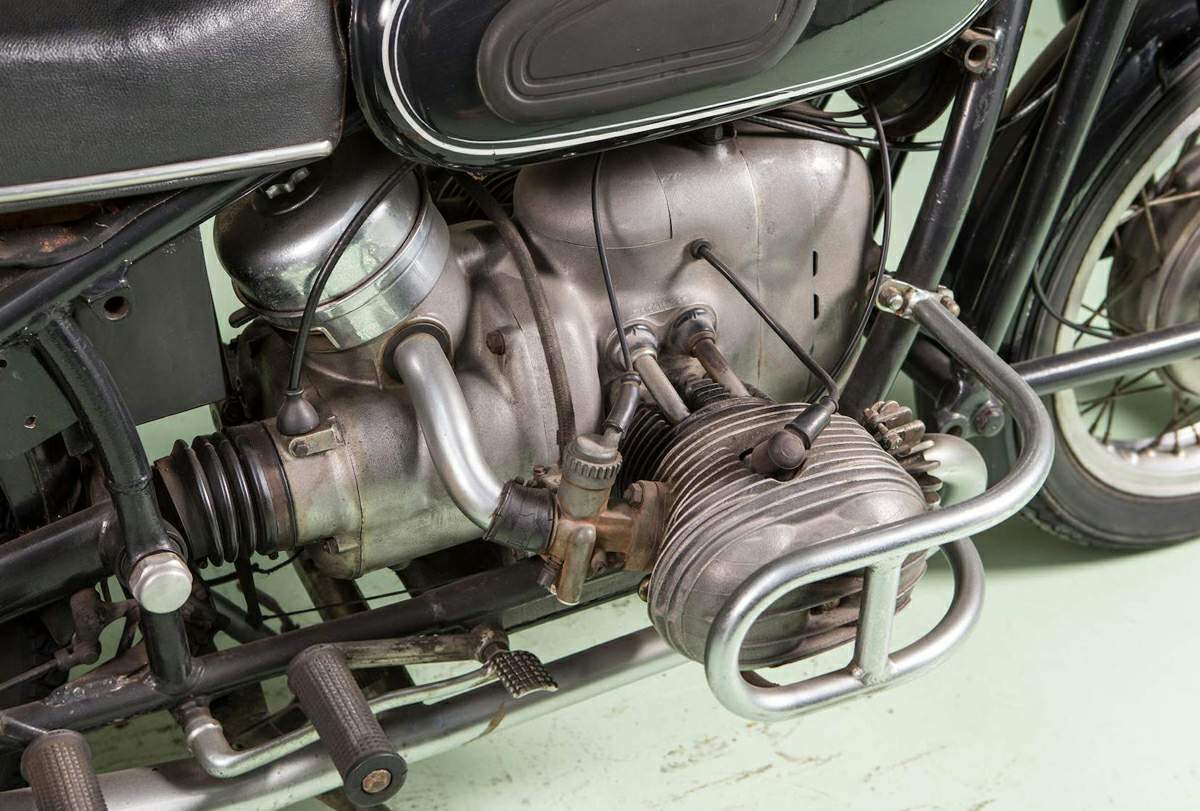
Front an rear pivoted-fork springing combined to furnish leech-like road
holding at all speeds and a high degree of insulation from bumps. The action
of the front fork was rather firm at low speeds, but was ideally suited to
fast riding. Pivoted at its nose, the pan-type saddle further enhanced the
rider's comfort.
High road performance necessitates good brakes. Those fitted to the R50
(both are of 8-inch diameter and the front has two leading shoes) were not
only uncommonly powerful, but they also matched the behavior of the
remainder of the machine in their smoothness of operation. The strength of
the return springs in the front brake mechanism made initial operation a
trifle heavy, but the brake was delightfully controllable except on its
first application in humid weather, when it had a tendency to grab. Because
front-brake torque is transmitted throughout the fork are, application of
the brake raises the front of the machine and stiffens the fork action. The
efficiency of both brakes was unimpaired by hours of rain and no brake
adjustments were required during a test of nearly 1,000 miles.
The electrical equipment of the BMW functioned most efficiently. The horn
was clearly audible to other drivers at all speeds. The rubber-mounted
headlamp threw a wide, flat beam which illuminated both sides of the road
for a sufficient distance ahead to permit speeds up to 80 mph to be used on
unlit main roads in perfect safety after dark.
Not a smear of oil appeared on the outside of the power unit although the
R50 was ridden hard for many hundreds of miles. In filthy weather, the
mud-guarding was found to furnish above-average protection.
Maintenance requirements have been reduced to a minimum on the R50; those
which remain can be carried out with great ease. Valve-clearance adjustments
are extremely accessible after removal of the rocker covers, each of which
is retained by three nuts. Two captive nuts secure the cast-aluminum front
cover to the crankcase. Removal of the cover exposes the contact breaker and
dynamo brush gear.
From stem to stern, the R50 is endowed with features which indicate that it
was designed by knowledgeable motorcyclists for connoisseurs. Both wheels
are quickly detachable and both have polished, light-alloy rims, straight
spokes, full-width hubs and nipples. Front-fork trail and shock-absorber
mountings are readily adjustable for sidecar work. Two-position pre-loading
of the rear shock-absorber springs for pillion work is effected by hand.
The key which operates the steering lock fits the tool box which is
concealed behind the left knee grip. A quick-release rubber strap secures
the battery on its platform, while rubber grommets prevent the ingress of
water to the carburettors at the point of entry of the throttle cables.
Firmly mounted in a reasonable clean position, the tire pump is fitted with
a rubber cap to exclude grit. In the modern continental trend, knurled
clutch and front-brake cable adjusters are incorporated in the handlebar
pivot lugs.
Finish of the R50 is serviceable black and white enamel, with a generous use
of chromium plating and many light-alloy parts highly polished. In short,
the latest R50 is one of the most outstanding contemporary models, combining
to an admirable degree high performance, silky running, quietness, comfort,
cleanliness and ease of maintenance. Its high engineering quality gives real
pleasure to the knowledgeable and should add appreciably to pride of
ownership.
